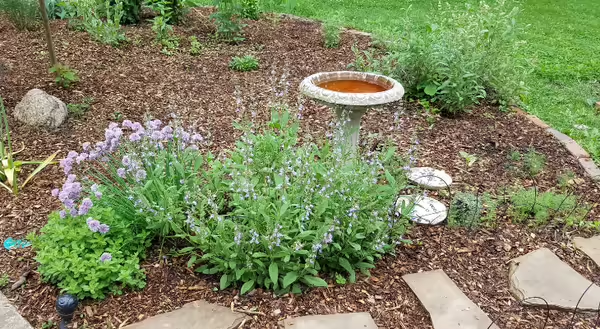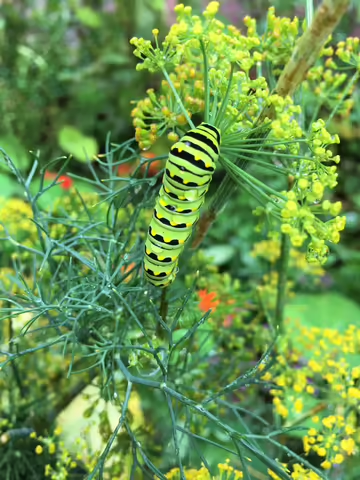
Herbs are a wonderful garden addition that provide easily accessible, fresh herbs for culinary use. However, I find that herbs are too often overlooked in most garden plans and can really provide a ton of ornamental and ecological benefits as well.
In general, herbs are pretty tough plants and do well in a variety of garden settings, making them relatively easy plants to include in most garden spaces. Beyond human culinary use, many herbs offer a variety of other benefits to the landscape, including ornamental beauty from attractive foliage and fragrant blooms as well as a great culinary benefit for wildlife since many support one or more life stages of pollinating insects.
Choosing herbs
When we think of herbs in the culinary sense, this term encompasses a great many plants and the same can be said from a horticulture perspective. The list of herbs used in gardening is long and includes both annual and perennial plants.
When planning an herb addition to your garden it is especially helpful to consider the plant’s life cycle.
- Annuals: In general, most annual herbs can be started from seed, either directly seeded into the garden or started indoors weeks earlier.
- Perennials: Most perennials are best planted as seedlings or rooted cuttings. In addition, many perennial herbs are easily divided and can pretty easily be sourced from other gardeners with established plants.
What herb plants need
Most herbs need full sun to thrive and be productive, but some, such as parsley and mint, can flourish in shade as well. It's safe to say that well-drained soils are an essential site requirement for most herbs and raised beds or containers are great alternatives if soil drainage is not adequate.
Interestingly, many of the fragrances and strong tastes that herbs have evolved serve the purpose of insect control. For the most part, good soil drainage is the best recommendation to prevent diseases. So, most herbs are relatively insect and disease-free and require little maintenance to simply grow and thrive in a garden location.
Use herbs for ornamental appeal
As ornamental plants, herbs are incredibly versatile and can be adapted to nearly any garden use from formal herb gardens, to simply being incorporated or interspersed into existing landscaping or vegetable gardening spaces. For those with limited garden space, herbs also flourish in containers both outdoors and indoors for year-round production.
From the fine-textured leaves of dill and fennel to the more coarse leaves of oregano and sage, the foliage alone is reason enough to integrate herbs into the landscape. However, nearly all herbs provide a wonderful flowering display at some point in the season and the diversity of sizes and shapes of flower structures is nearly as wide as the flavors they add to food.
In some cases, such as with many annual herbs such as basil and cilantro, the culinary qualities of the plant become compromised once flowering is initiated. So, many gardeners manage these plants in a vegetative state for as long as possible by harvesting or removing blooms. However, once they do go to flower, whether you wanted them to or not, rest assured that insect life will take up the remaining “culinary use” of the plant.
Plant herbs for pollinators
Flowering herbs are hugely beneficial to native pollinators as they provide excellent floral resources for a large chunk of the growing season. When in bloom, there is always a buzz of activity in my herb garden with everything from majestic butterflies to tiny hoverflies and honeybees visiting the space. In addition, many herbs are quite fragrant when in bloom adding another level of human olfactory pleasure to the brilliant blooms.
Beyond floral resources for adult pollinators, many herbs also support their larval forms. The eastern black swallowtail butterfly (Papilio polyxenes) lays eggs on members of the carrot family (Apiaceae). This native caterpillar utilizes both native and nonnative members of Apiaceae, including several herbs such as dill, fennel and parsley. Young larva mimic the appearance of bird droppings with a black and white, brindled color scheme, while older instars have a wonderful splash of green and yellow intermixed creating a striking and uniquely camouflaged color scheme.
While supporting pollinator populations is increasingly important for biodiversity, given the recent and drastic declines in global insect life, attracting pollinators can also increase garden productivity. We know that gardens which attract more pollinators are more productive since these insects boost flower pollination which boosts fruit yield. In addition, many pollinators are predators of insect pests that frequent our vegetable crops.
Whether it’s a patch of herbs in your existing vegetable garden or a new herb container garden right by the back door, now is the time to integrate these beautiful and delicious plants into your home garden.
